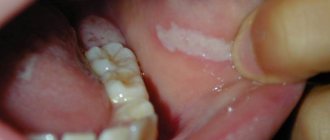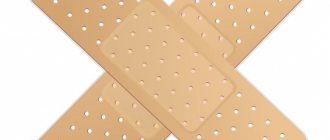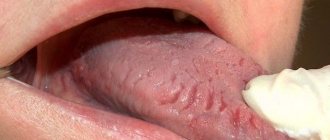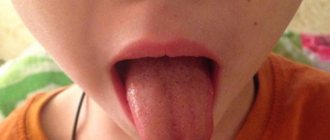1.General information
The apt, albeit somewhat frivolous name “geographic tongue” refers to the inflammatory-dystrophic process in the mucous membrane of the tongue, also known as “wandering glossitis”, “migratory oral erythema”, “exfoliative glossitis” (formulation in ICD-10), “desquamative glossitis”, etc. Exfoliative in translation means “flaky”, desquamative means “deprived of scales”, glossitis is inflammation of the tongue. Peeling of the epithelium in combination with inflammation and dystrophic changes together form red and white patterns on the tongue, which in many cases really resemble a fragment of a geographical map.
In different historical periods in medicine, there were different views on the essence and pathogenesis of desquamative glossitis (the term and concept were introduced into the medical paradigm in 1831), and the discussion continues to this day. Thus, some authors consider this process to be neurodegenerative, others to be purely inflammatory, and others generally consider it as a non-pathological variant of the norm.
The prevalence of “geographic language” varies significantly depending on the age, gender, and clinical composition of the studied samples; in terms of the general population, it is estimated at 2-5% of the population. There is a slight predominance of women, children and adolescents.
A must read! Help with treatment and hospitalization!
Preventive actions
To prevent the appearance of geographic language in yourself and your loved ones, you must observe the following measures:
- Promptly treat emerging diseases of the body, especially those that provoke the appearance of a geographic tongue.
- Complete elimination of bad habits (irrational consumption of caffeine, sugar, elimination of alcohol and smoking cessation).
- Prevention of vitamin deficiency (periodic intake of multivitamin complexes, consumption of vitamin B).
- Regular oral hygiene.
- Timely treatment of oral diseases (especially teeth affected by caries).
To prevent the disease from occurring in a child, it is necessary to take care of baby teeth, promptly treat caries and remove teeth that cannot be treated. If a child feels dry mouth, then before bedtime and after meals, rinse with herbal decoctions for rinsing. Herbs you can use are St. John's wort, sage or chamomile.
If a child feels unpleasant dryness in the mouth, then you can put a piece of bandage on his tongue that has been previously soaked in any oily product (fat or butter). The holding time of lotions should not be more than 5 minutes. You should urgently take your child to the doctor if he is diagnosed with geographic tongue.
To clean children's teeth, it is better to give them toothpaste rather than tooth powder, which contains menthol and peppermint oil, which negatively affect the child's tongue.
It is better for teenagers to know that drinking alcohol and cigarettes is extremely undesirable during this period of life.
You should definitely think about it and take measures to increase the body’s immunity and resistance. Nettle, basil, turmeric, dandelion, and coriander are good for this purpose. Natural immune boosters include ginseng, echinacea and ginger. These plants should be drunk daily instead of tea.
To restore intestinal function, you need to eat fermented milk products every day. Herbal mixtures with lemon balm, yarrow, eucalyptus, currants and St. John's wort normalize the microflora well.
2. Reasons
There is no single point of view regarding the etiopathogenesis of inflammatory desquamation of the tongue; the issue continues to be studied and discussed. According to the most reasoned hypotheses, the cause may be infections (both bacterial and viral), hereditary predisposition, diseases of the liver, pancreas, gastrointestinal tract (primarily gastritis, gastroduodenitis, peptic ulcer and intestinal malabsorption syndrome), endocrine and metabolic disorders, exudative diathesis in children, autoimmune diseases, helminthiasis.
Visit our Gastroenterology page
Interesting
Pigs are more sensitive than people. The person is a fairly average taster. He only has 3 thousand taste analyzers. The whale, which swallows a lot of fish without even chewing, has only a few or none at all. The pig, oddly enough, is more taste-sensitive than humans: it has 5,500 taste analyzers. A cow has 35,000 of them, and an antelope has more than 50,000! So not only do animals have a sense of taste, but many of them are much better tasters than humans. Marine animals are often covered in taste buds on the outside. Fish, for example, sense taste over the entire surface of their body. But creatures such as flies and butterflies can taste with their paws. Snakes and lizards use language for this purpose, but not quite in the same way as we do. They seem to shoot out the tip of their tongue, which catches small particles of food. These particles are delivered using the tongue to a special organ in the upper part of the mouth, which tastes and smells food.
3. Symptoms and diagnosis
The first manifestations are usually small, up to several millimeters, light gray lesions. Then such an area from the center turns red and swells somewhat, beginning to protrude above the surface and become covered with red papillary dots. The shape of desquamation foci can be very different, from round to arched. The alternation of inflamed, exfoliated and keratinized areas (usually they are multiple) forms a bizarre picture that can change quite quickly. The process is usually localized on the upper and lateral surfaces of the tongue, sometimes spreading to the lower areas.
In rare cases, desquamative glossitis causes subjective discomfort at the level of sensations - usually a burning or tingling sensation, less often pain when eating. In most cases, the disease is asymptomatic, for years or even decades; A recurrent (recurrent) type of course with long-term remissions is often noted.
To establish a diagnosis, an examination, collection of complaints (if any) and anamnesis are usually sufficient. However, given the importance of desquamative glossitis as a possible indicator of serious diseases, a multifaceted laboratory study is indicated (they begin with the appointment of general clinical and biochemical tests).
About our clinic Chistye Prudy metro station Medintercom page!
Black hairy tongue (lingua villosa nigra)
Black hairy tongue
Black hairy tongue, or lingua villosa nigra in Latin, is a generally painless and harmless condition characterized by the appearance of a black, moss-like coating.
The nature of the problem usually consists of two conditions - the papillae (taste buds) acquiring a blackish or brownish color and their growth in length. The black, hairy appearance of the tongue can be alarming and bothersome, especially when accompanied by bad breath and a feeling of nausea.
Causes
A black hairy tongue occurs due to the accumulation of bacteria, food debris, and other microorganisms on the papillae. The hairy appearance is therefore acquired as a result of the elongation of the papillae themselves when they are unable to rid themselves of accumulated debris. Why this happens is not entirely known, but here are some potential factors that may cause a black hairy tongue:
- insufficient and poor oral hygiene is the main cause of a furry tongue in many cases;
- excessive consumption of coffee along with frequent smoking of tobacco, including cigarettes;
- reaction to certain medications, e.g. those containing bismuth or antimicrobial components, such as tetracycline;
- regular use of mouthwash containing oxidizing and astringent agents such as methanol, witch hazel and peroxide;
- decreased saliva production or flow rate;
- black hairy tongue is also common in people without teeth, as they eat soft foods that are not abrasive to the surface of the tongue (soft foods do not remove dead cells);
- A weakened immune system, which may be caused by HIV/AIDS or diabetes, is also likely a factor;
- dry mouth.
Treatment
Usually, black hairy tongue goes away on its own, but you can speed up the process by eliminating some of the factors that may trigger its occurrence. During treatment, the goal is to restore the normal color or appearance of the affected tongue. Here are the best methods for treating black hairy tongue:
Regular brushing of teeth, mouth and tongue
Regular brushing of your teeth, gums and tongue with a soft-bristled brush will help get rid of accumulated bacteria and food debris on the tongue, hence preventing the problem from developing.
Moisturizing the mouth
You can prevent dry mouth by drinking enough water. Remember that when the oral cavity is not sufficiently moistened, the growth of bacteria and other microorganisms increases and their accumulation in the papillae. Therefore, keeping your mouth hydrated is very important.
4.Treatment
In cases of asymptomatic disease, if there are no signs of underlying somatic diseases, therapy is not required and is not prescribed. The exception is the mandatory sanitation of problematic teeth and oral cavity, as well as normalization of the diet - which, however, is indicated for absolutely all people.
If there are symptoms of a particular disease that may be the cause or basis for the development of desquamative glossitis, the patient is referred to a specialist of the appropriate profile, where he receives etiopathogenetic treatment.
What does Dr. Komarovsky advise?
To cure your child faster, it is recommended to follow the doctor’s advice:
- Do not scratch or injure your tongue. During the treatment period, food should be soft , not hard. Spicy and too hot dishes are prohibited.
- The child should be prohibited from scratching his tongue. This can lead to wounds and complications.
- It is imperative to show the child to the doctor. Geographic language always signals larger problems .
- It is recommended to give the child vitamins or vitamin complexes. It is quite possible that the child has vitamin deficiency. This method will help restore the child's health.
- There is no need to rush to give your child serious medications . Usually vitamins and various lotions help to heal. Recovery occurs within two weeks.
Incredible!
Language helps you see. A revolutionary technology that makes it possible to partially restore vision to blind people using the nerve endings of the tongue was created by American scientists. The theoretical basis for the latest technology was laid back in the 1960s by the famous neurosurgeon Paul Bach y Rita. He suggested that a person sees not with his eyes, but with his brain. In this case, vision serves only as a “delivery” of external light signals. Now these scientific assumptions have been confirmed in practice, when scientists have created a special device that largely restores vision. It consists of glasses that capture light and transmit information to a special miniature device. The latter converts light waves into electrical signals that are sent through a thin cable to the tongue. The tongue was chosen as a channel for transmitting signals to the brain, since its nerve endings are very sensitive and capable of transmitting a large amount of information. Thus, the tongue partially replaces the 2 million optic nerves that lead from the human eyeball to the brain. As it turns out, the impulses received by the tongue are converted into images in the brain. The magazine reports that during the tests, blind people using the latest device were able to see the door, floor call buttons in the elevator, and even letters.
ethnoscience
Home therapy will help reduce the symptoms of glossitis without threatening your health. To eliminate manifestations of geographic language, you can use:
Decoction of oak bark. Pour 1 tsp of boiling water over a glass. raw materials and boil for 10 minutes. Cool to room temperature and strain. Rinse your mouth several times a day.
Sunflower oil . Before use, the product must be boiled and cooled to room temperature. Lubricate the affected tongue with a cotton pad 5-6 times a day. Important! Before each use, the product needs to be warmed up a little.
Natural honey . This beekeeping product must be dissolved in the mouth. To do this, it is recommended to use 1 tsp after each meal. honey
A decoction of oak bark and chamomile . Add 1 tsp to a glass of boiling water. oak bark and 1 tsp. daisies. Cook over low heat for 7-8 minutes. Strain and cool. Rinse your mouth 2-4 times a day.
Bedstraw decoction. Pour 1 tsp boiling water over a cup. raw materials and boil for 3 minutes over low heat. Rinse your mouth three times a day.
Calendula decoction . Take 1 tsp. chamomile flowers and pour a cup of boiling water. Cook over low heat for 10 minutes. Carry out the procedure 2-5 times a day for 3 minutes.
Soda-iodine solution . Dissolve 3 pinches of soda in a glass of warm water and add 3 drops of iodine. Rinse your mouth at least 3 times a day.
Essential oils . Mix tea tree oil in equal proportions with sea buckthorn or olive oil and lubricate the affected tongue.
Potato juice . Grind one medium potato in a blender and strain through cheesecloth, collecting the juice. Carry out the rinsing procedure 4 times a day.
Vaseline compress . To prevent dry tongue, lubricate it with Vaseline. The product will help eliminate not only the cause of dryness, but also slightly heal cracks.
In addition to all of the above, it is necessary to note the juice of aloe, plantain and Kalanchoe. These remedies help heal wounds and relieve inflammation.










